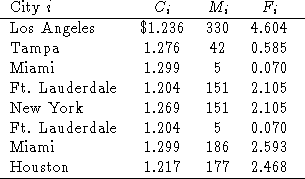An important problem for airlines is the determination of how much fuel an airplane should load at each stop. Since the efficiency of an airplane is related to its weight, an airplane fully loaded with fuel burns more fuel per mile in flight. This fact argues for planes filling up at each stop with just enough fuel to take them to their next stop.
Unfortunately, since fuel prices vary substantially from one location to another, this policy of minimal fill-ups may be more costly than filling the tank at an inexpensive location. Airlines need to achieve the appropriate balance since fuel costs are, by far, the single largest item in airlines' costs.
Consider the small example of an airplane that flies the following ``rotation:"
Los Angeles ![]() Tampa
Tampa ![]() Miami
Miami ![]() Ft. Lauderdale
Ft. Lauderdale ![]() New York
New York ![]() Ft. Lauderdale
Ft. Lauderdale ![]() Miami
Miami ![]() Houston
Houston ![]() Los
Angeles (completing a cycle). Table 1 shows, for each leg and city i,
Los
Angeles (completing a cycle). Table 1 shows, for each leg and city i,
![]() , the fuel cost per gallon in city i;
, the fuel cost per gallon in city i; ![]() , the
minimum gallons of fuel needed to get from i to the next stop; and
, the
minimum gallons of fuel needed to get from i to the next stop; and ![]() , the
additional fuel (in 0.01 gallons) burned per gallon of fuel loaded over
the minimum,
, the
additional fuel (in 0.01 gallons) burned per gallon of fuel loaded over
the minimum, ![]() .
.

Table 1: Fuel Costs and Requirements
For example, in Los Angeles, the airplane could be loaded with 330 gallons, which would just
make it to Tampa. Alternatively, in order to fill up with enough fuel in LA to get to
Miami without refueling at Tampa, ![]() gallons would be
required. The last term
gallons would be
required. The last term ![]() represents the extra fuel burned on the trip from
Los Angeles to Tampa due to the presence of the additional 42 gallons loaded in LA.
represents the extra fuel burned on the trip from
Los Angeles to Tampa due to the presence of the additional 42 gallons loaded in LA.
Comparing costs for these two simple alternatives:
Formulate a linear program to determine the least-cost locations and fill-up amounts for the rotation above.